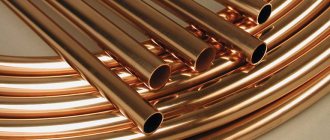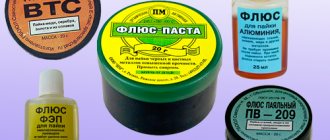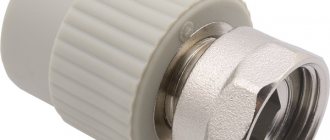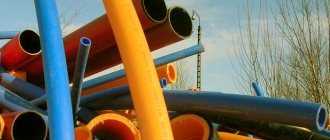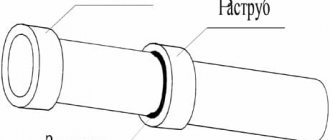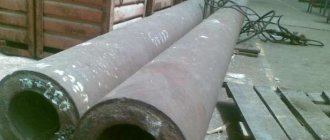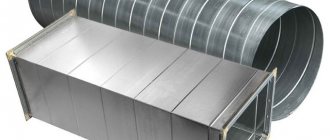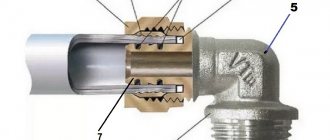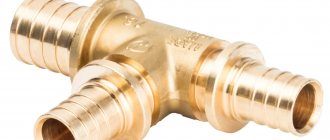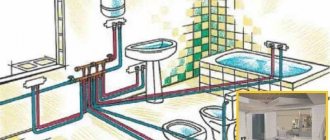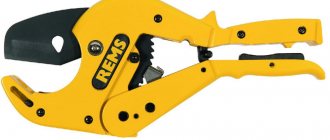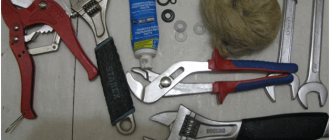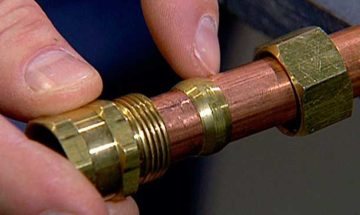
Everyone knows that various technologies and materials can be used for the installation of pipelines: steel and its types, metal-plastic, plastic.
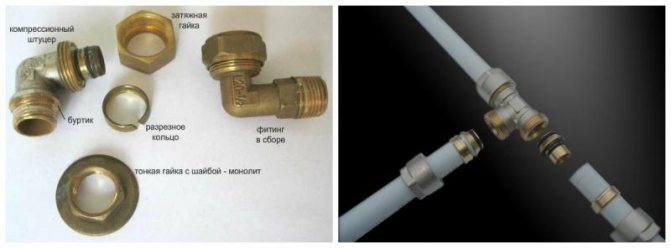

Anyone who has ever faced the issue of installing pipes knows that copper pipes are very reliable and practical - they do not corrode, their use excludes the release of toxic and harmful substances and compounds, they are striking in their plasticity and elasticity, and can withstand heavy loads. Threaded fittings for copper pipes are the best connection method, although others are practiced, such as welding or compression.
Threaded fittings are used when there is a need for frequent assembly and disassembly of the pipeline, focal turns, the need for branches, rasstroy, corners, joints of pipes of the same and different diameters. They differ from the rest by the presence of an internal and external thread, which guarantees the quality of the connection. Since threaded fittings are subject to constant inspection, they are used in places where access is not difficult.
They are also indispensable for the repair or reconstruction of the water supply system. The thread of the fitting is often cylindrical, the same as on the pipe to be connected. Their main advantage is the possibility of repeated use.
Threaded fittings
Below we will look at the types of fittings for copper pipes.
According to the material of manufacture, threaded products are divided into:
- uncoated products zinc-plated (zinc-plated) chrome-plated (chrome-plated) nickel-plated (nickel-plated)
In principle, it is understood that the coating enhances the properties of copper and provides additional protection and strength to the connection, therefore it is more reliable and practical.
By design, threaded fittings are divided into the following types:
- tees; elbows; plugs; couplings; nipples; bends; crosses and others.
In addition to copper, they are made from brass, stainless steel, cast iron, bronze and other metals, compounds, materials, including plastic and metal-plastic.
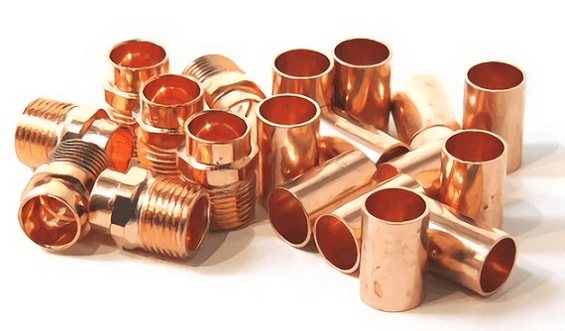

Types of threaded fittings
Features of the connection of copper pipes
When installing using crimp fittings, use brass or bronze products with a special ferrule, which is located inside the fitting. The connection is made using a wrench. A little effort - and even for someone who has never installed a pipeline, everything will come out without problems and the first time.
A significant disadvantage of the crimp connection method is a low degree of reliability - such a connection is categorically inapplicable in the presence of increased pressure in the pipes. Prevention, expressed in tightening the nuts, carried out regularly, will help extend the life of such a pipeline. It often happens that during preventive tightening, deformation of the fittings occurs, do not despair - just replace the broken product.
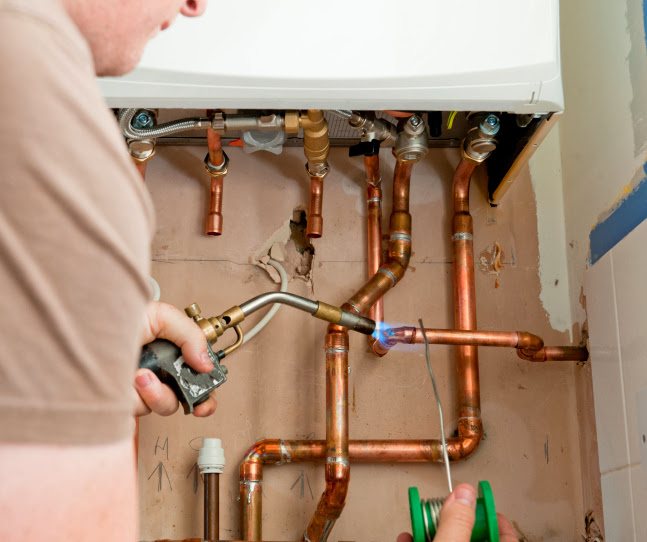

Threaded copper fittings are used where crimping and other options cannot be used - it is impossible to solder pipes or you need to combine pipes made of different types of metal.
So, if you decide to resort to soldering, then it is worth considering - maybe it is better to use threaded fittings for copper pipes. You will not worry about corrosion and deformation due to temperature fluctuations, the presence of substances passing through the pipes.
Diy copper pipe plumbing
Copper pipes are the most acceptable option for organizing a water supply network. The presence of various impurities in water does not affect the structure of such products. Due to their properties, they can be actively used in heating, air conditioning and gas transmission systems. The connection of pipes during installation is made by crimp fittings or by soldering.
Installation of copper pipes can be done using a compression fitting
Methods for installing copper pipes
There are two common ways to connect copper pipes into a single system:
- brazing (or welding for large diameter pipes);
- threaded connection using a ferrule.
As for the threaded connection, it is so elementary in execution that even a person who does not have any experience in installing copper pipes can handle it. Also, no special tools are required - installation is performed using simple wrenches.
The main thing in this case is to choose the right diameter of the fitting so that it matches the diameter of the pipes.
And a characteristic feature of such a connection is that it is detachable, that is, it can be easily disassembled if necessary (for example, when dismantling a pipeline or repairing it).
Note! This type of connection needs regular checking and tightness control. The fact is that changes in temperature or water pressure in the system can cause a weakening of the threaded assembly, so it will have to be tightened periodically. In the event that the unit is being repaired, the crimp ring must be replaced with a new one.
Soldering (welding) is a permanent joint of pipes, such a unit does not need maintenance, therefore it is considered more reliable. But to perform the brazing of copper pipes, you must have sufficient experience in such work.
The main advantages and areas of use of copper piping
Copper pipes have an operating temperature from -200 to +250 degrees, as well as a low linear expansion, which allows them to be successfully used for such systems:
- Heating;
- Plumbing;
- Conditioning;
- Gas transportation;
- Receiving alternative energy, for example, solar systems.
When installing copper pipelines for supplying cold and hot water, there is no need to worry about overgrowth or silting of the inner section. Also, they are not destroyed by chlorine, which is added in high concentration to tap water.
On the contrary, chlorine creates the thinnest protective layer on the inner wall of pipelines, which significantly extends the service life of the pipelines. In turn, a small amount of copper is released into drinking water, which has a beneficial effect on human health.
Assembling the pipeline using fittings
The connection of copper pipes with fittings is carried out exclusively in places accessible for inspection. This rule is due to the fact that the connection is not completely sealed and leaks may form over time.
The advantage of a threaded connection is that, if necessary, repairs can be made without additional efforts, since the resulting connection is detachable.
Tools and materials
To assemble the pipeline, you will need the following materials and tools:
- copper pipes of a suitable diameter;
- connecting crimp or press fittings;
Special devices for pipeline assembly
The types and number of fittings are selected in accordance with the pipeline diagram.
- pipe cutter or hacksaw for metal;
- pipe bender for copper pipes. The device is used to organize a pipeline with fewer connections, which increases the strength of the system;
- file for processing pipes after cutting (before joining). Additionally, you can use fine sandpaper;
- FUM tape for thread sealing. In addition to FUM tape, you can also use linen thread, Tangit Unilok thread or any other sealing material;
- wrench.
Assembly instructions
Do-it-yourself assembly of a copper pipeline using fittings is done in the following way:
- cutting pipes for the pipeline. The length of each pipe must fully comply with the diagram drawn up during the development of the system;
- removal of the insulating layer. If pipes with insulation are used for a pipeline system to be equipped for any purpose, then for a strong connection, the insulating layer is removed. For this, the desired section is cut with a knife and the pipe is cleaned;
- the cut edge is processed with a file, sandpaper until a flat surface is obtained. If burrs, potholes or other irregularities remain at the end of the pipe, the connection will turn out to be less tight;
Stripping the pipe before connecting to the fitting
- bending of pipes is performed if necessary;
- a union nut and a compression ring are put on the prepared pipe;
Installing fitting elements for connection
- the pipe is connected to the fitting. Initially, tightening is done by hand and then with a wrench. During the tightening process, the ferrule completely seals the connection, which eliminates the need for additional sealants. However, when connecting a copper pipe to a pipe or fitting made of a different material, additional sealing with an FUM tape is required.
It is important not to overtighten the threads as soft copper deforms easily.
Materials for the installation of copper pipes
To calculate the exact amount of materials required, it will be necessary to pre-design a pipeline of copper pipes.
As a rule, drawing up a scheme for laying and routing pipes is the first stage in the installation of any communication system.
The more accurate it is, the easier it will be to calculate how many materials will have to be purchased. So, for the installation of a copper pipeline, you will need:
- pipes - they should be bought with a small margin, since a certain amount of centimeters will "go away" when cutting and making connections;
- fittings - the choice of a specific type depends on the installation method and the system diagram. If you plan to mount a pipeline from copper pipes using soldering, then you need to buy the appropriate fittings, and if you want to assemble the system using threaded connections, you will need fittings with ferrules. All turns and branches of the system are also performed with their help: various tees, turn signals, elbows and adapters from one pipe diameter to another;
Source: https://galaxys6blog.ru/vodoprovod-iz-mednyh-trub-svoimi-rukami/
Installation types
Two types of copper pipeline installation are actively used:
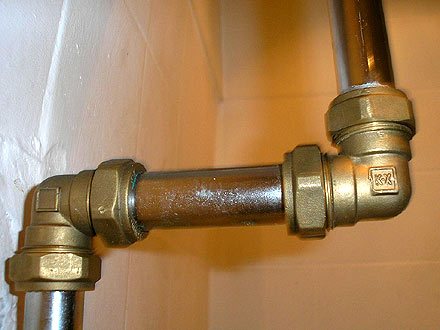

- brazing threaded connection (using ferrules)
The second type is much simpler and less expensive, you do not need additional equipment - just tighten the fitting with a wrench. No fire hazard or surprises.
You will achieve a strong connection without resorting to any hard work! If possible, try to use homogeneous metals (copper or copper alloys), this will help increase the life of the pipeline without additional expenses for repair work.
What is useful for making a connection using threaded fittings?
Nothing supernatural:
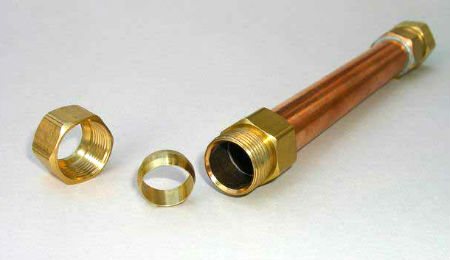

- a hacksaw for metal (or a special cutter), with which you will cut the pipe into pieces of the size you need. Tip: the cutting blade should be changed before work; wrench; pliers; file; calibrator; sandpaper.
Please note that for piping installation, in addition to pipes and fittings, you will need sealing tape.
Installation
During installation, the nut is joined with the fitting, after which the thread is tightened - first by hand, then with a wrench. If joining with pipes made of other materials cannot be avoided, fum tape will come to the rescue, which is screwed onto the threaded part under the fitting.
If you do not want to speed up corrosive processes in the joint, do not use a transition from copper to galvanized or unalloyed steel. Electrochemical processes occurring between these metals can reduce the life of the pipeline.
How to choose?
In order to properly mount the system, it is necessary to take into account the features of the threaded fittings. You should focus on the purpose of the pipes, if you use high-quality materials, pay attention to all the rules - you are guaranteed a high-quality connection for many years. Find out what the sizes and purpose of fittings are, use it in the design.
Choice of fittings
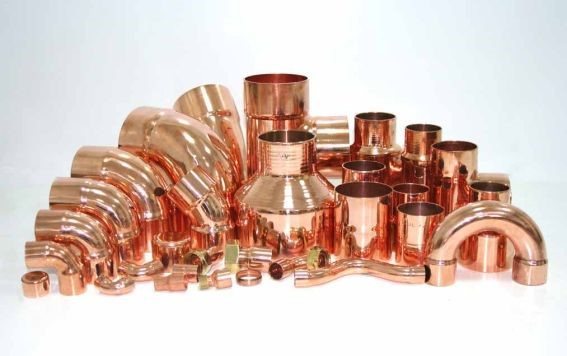

If you need to rotate the structure, the corners will come in handy, if you have planned branching, be sure to purchase tees, crosses, collectors. If you just need to connect two pieces of pipe (of a given or different diameters), stock up on couplings, and, of course, do not forget to buy plugs.
Where to apply?
Copper pipes with threaded fittings are highly competitive, despite the fact that many other types of connections and materials for the manufacture of pipelines have appeared in the world. And all thanks to the almost magical properties of copper - disinfection of water when broadcasting through pipes, the pipe itself does not oxidize, does not rust, products made from it are very reliable, but at the same time plastic, characterized by resistance to temperature extremes and fluctuations from high to low.
Where is the area of application of copper pipes?
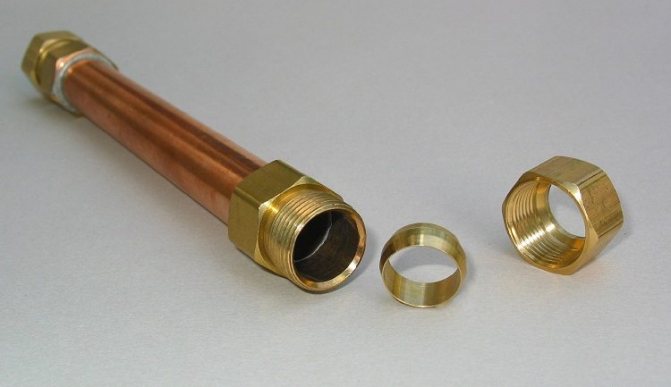

Believe me, everywhere! These lightweight and durable pipes take place in the design and laying of air ducts, and the crimp type of copper fittings is actively used in communication networks. Wherever you will not find a copper pipe - in heating systems and appliances, in air conditioners, in gas appliances and pipelines, in the water system - copper is always present. Some enthusiasts of experiments use copper pipes as an element of decor or interior - they take any shape and can be connected to any other pipe (and not only), are interesting for their unique color and brilliance.
Tight joining of copper pipes without soldering
Additionally, it should be noted that, despite the fact that the connection of pipes by soldering is considered the most reliable method in most cases, there are still situations when it is not possible to use this method. In such cases, you can resort to the connection of copper pipes without soldering. Special fittings will be required to ensure a secure connection due to the clamping effect that occurs when threaded connections.
In this case, the connection is made in the following sequence:
- First, the fittings are disconnected, which often have two parts.
- One of the elements is put on the pipe. Typically this is a nut and a clamping ring.
- Next, a pipe is threaded into the fitting and the nut is tightened.
Usually, such fittings are equipped with detailed instructions, which must be followed without fail, otherwise the work performed will be of poor quality.
It is worth noting that before connecting copper pipes without soldering, it is worth realizing all the risks, since it is rather difficult to obtain a high-quality connection. Minimal distortions of the parts to be connected are not allowed at all, otherwise the technology is grossly violated. To make the threaded connection extremely tight, it is advisable to additionally seal it with special threads.In this case, it is worth making sure that they do not end up on the inside of the pipe, since subsequently the water may not pass through the system properly.
How to mount?
Some of the installation recommendations were given above, however, if you are not sure that you can do the job efficiently, you better do not take it.
You can ask any familiar craftsman from the people or call a team or one professional. It's up to you to decide. But you shouldn't retreat from your decision to make a copper system.
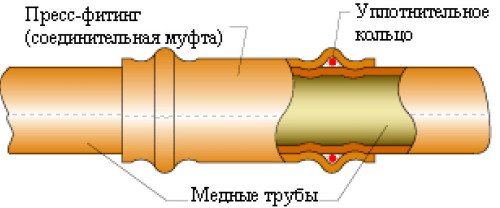

An extensive selection of types and directions of connections, tightness and reliability, environmental friendliness and aesthetics are not all the advantages of a copper pipeline. Do not forget that you can solder and weld these pipes, connect using threads and flanges, crimps and compression technologies. Copper fittings help you assemble the system the way you need it, rather than adapting to the "material", and it will be leakproof and practical, and the time you spend on installation will be much less than if you take advantage of other options and possibilities.
Successful construction work!
If your piping design requires multiple disassembly and reassembly, threaded copper pipe fittings are best suited for installation. Their difference from others consists in the presence of a thread on the outside or inside, with the help of which the connection takes place. Threaded fittings are quite practical, but they lag behind in terms of reliability, and, as a result, they need periodic monitoring of the condition of the connections.
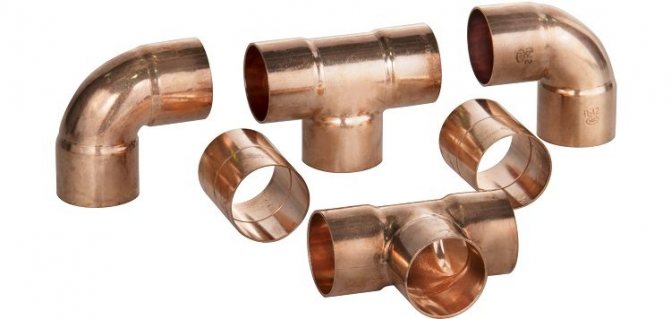

In this regard, in most cases, their use is advisable in easily accessible places of the pipeline. Another direction for the use of threaded fittings is the repair or reconstruction of the water supply system. Threaded fittings are quite practical, but they lag behind in terms of reliability, and, as a result, they need periodic monitoring of the condition of the connections. Brief description of threaded fittings Threaded fittings are one of the main types of connections. pipelines These are collapsible parts that are used to repeatedly connect system elements. Their design provides for the presence of an external or internal thread.
As a rule, this thread is cylindrical. Threads are provided both on the fittings themselves and directly on the pipes. Their advantage is reusability.
Threaded products are suitable not only for connecting elements, but also for installation with plumbing or pipeline fittings. The above-mentioned fittings can be classified as: uncoated; zinc-plated (zinc-plated); chrome-plated (chrome-plated); nickel-plated (nickel-plated) Naturally, plated fittings provide more reliable anti-corrosion protection. Threaded fitting belongs to one of the main types pipe connections. The range of threaded elements is huge. These are products that are different in type and design: elbows; tees; bends; nipples; couplings; plugs; fittings and so on. The material from which threaded fittings are made is also diverse: cast iron; brass; stainless steel; bronze; and, finally, copper. This is just about copper fittings and the further story will go. Copper pipes.
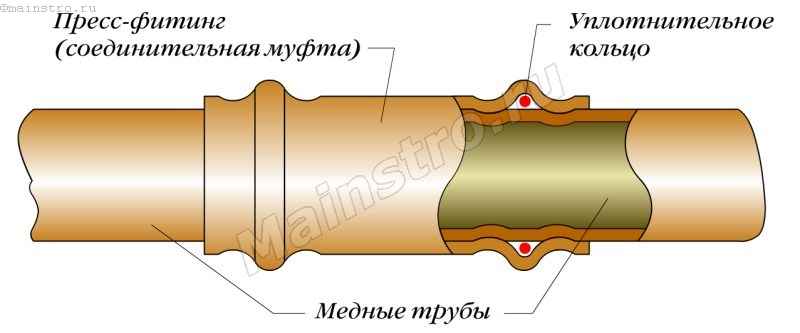

Connection features Brass and bronze fittings are suitable for crimping copper pipes. The tightness of the connection is ensured by the presence of a special compression ring inside the fitting. To perform the crimp, you need a wrench and a little effort when turning the nut.
No additional devices are required. Even if there is no experience in installing copper pipes, it will be easy to cope with such work. The disadvantage of such a connection is insufficient reliability. There are a number of restrictions on the pressure inside the pipes when connecting with the above method.
To maintain tightness, do not forget about prevention and timely tightening of the nuts. If, with frequent tightening of the nuts, a deformation of the fitting occurs, it is necessary to replace the failed connection element. Connection using threaded fittings is used mainly where there is no possibility of soldering copper pipes or it is necessary to combine pipes from different materials. If you decide not to use soldering when installing a water supply system, then the method using threaded fittings is ideal for you. Reliability, accessibility of installation and anti-corrosion properties. copper pipes will stop your choice on the copper option.
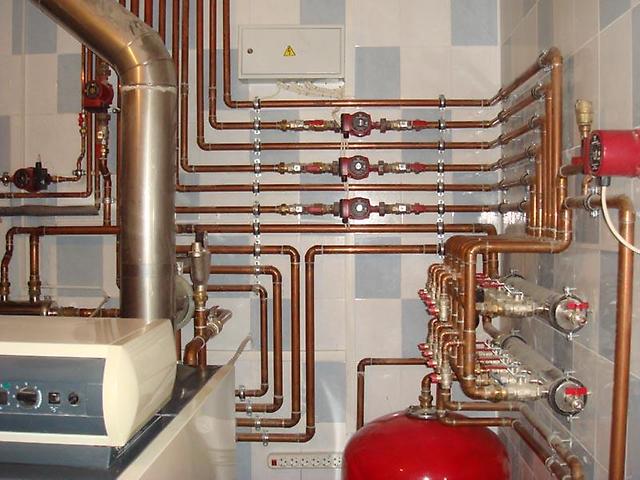

Another plus is high resistance to temperature fluctuations. There are two main types of installation. This is mounting by soldering and by means of threaded connections using ferrules. After reading the name of the above method, one may doubt the ease of installation.
But this is not the case. Simplicity and accessibility are the motto of this method. You don't need any special tools, just wrenches are enough.
And even with such an installation, there is no need to comply with fire safety techniques. When installing copper products, whenever possible, use homogeneous materials (copper and its alloys). This will increase the service life of the structure. You will need: a special cutter or a hacksaw for metal (with their help you will saw pipes into pieces of the required size, when using a hacksaw, do not forget to replace its blade with a new one); a calibrator; wrenches; a file (with you will clean the burrs at the cutting points); pliers; to remove the oxide film you will need a sandpaper. These are tools, and the following materials are needed: copper pipes directly (with a threaded connection, a stock of a couple of meters will not hurt); fittings (tees, adapters, etc. .) depending on the plumbing scheme; special fum tape for sealing. And now about the order of work. First, you need to saw off the desired section of the pipe (check with the diagram). If you are using pipes with insulation, then do not forget to remove the protective layer at the site of the future connection. Make a cut and remove the insulation. Using a file, remove burrs at the cut. Prepare the fitting: first put on the nut and then the ferrule. Butt the nut with the fitting and tighten the threaded joint.
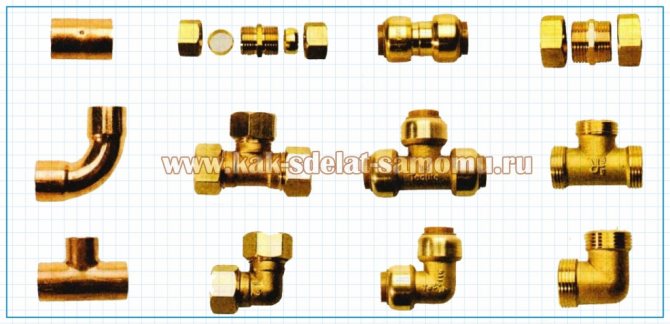

Tighten the nut slowly, first by hand, and then with a wrench. If, when installing copper pipes, it is necessary to connect to a steel pipe, then it is appropriate to use fum tape. It is screwed onto the thread, then the fitting is screwed on. and the tight connection is ready. When installing copper products, whenever possible, use homogeneous materials (copper and its alloys).
This will increase the life of the structure. Useful tips for installing copper pipes When installing copper products, whenever possible, use homogeneous materials (copper and its alloys). This will increase the life of the structure. If this advice does not work, then you need to adhere to the following rule: do not allow galvanized unalloyed steel to be connected to copper (with such a connection, you will get faster corrosion of steel elements due to electrochemical processes). pipes.https: //experttrub.ru/youtu.be/YyD0_qTuj4Y "width =" 640 "height =" 425 "style =" max-width: 100% "> The choice of fitting depends on the purpose of the pipeline. A professional approach to the connection, high-quality materials will increase the service life of the structure. The size of the fitting for copper products is easy to choose, since there is a standard and nomenclature.
Products manufactured by different companies are interchangeable. The size is determined in accordance with the inner diameter, wall thickness, socket depth and gap width. Types of fittings depending on the purpose By purpose, threaded fittings for copper pipes are classified as follows: various angles (90 or 45 degrees). Their purpose is to rotate the product to the desired degree; collectors or tees, allowing you to make a branch from the main structure; crosses.
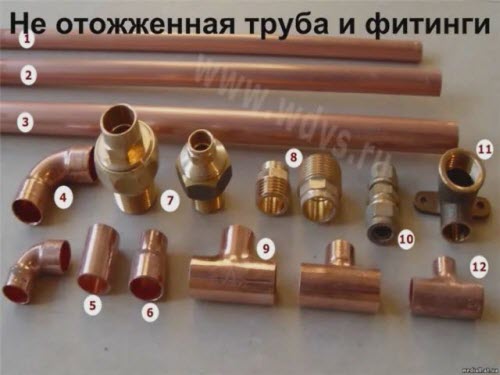

Provide the ability to carry out independent branches while maintaining the main direction; couplings.Designed to connect straight sections with the same diameter or different. Also suitable for joining elements made of different materials.
plugs, caps - overlap the end of the copper system; fittings carry out the outlet of a flexible rubber tube, etc. Fields of application of copper pipes and fittings The competitiveness of copper pipes and fittings made of copper remains quite high in our time, even in the presence of other high-quality materials. All this is due to the positive qualities of copper. Copper does not allow microbes and bacteria to get into the water, does not oxidize and is not subject to rust, the products are quite plastic and reliable, resistant to both high and low temperatures. ”640 ″ height =” 425 ″ style = ”max-width: 100%”> When using copper pipes, duct networks are installed.
Copper crimp fittings are successfully used in the creation of engineering communication networks. Gas supply, heating, air conditioning systems, water pipes - none of these industries can do without the use of copper products. Not only because of the high quality, but also as an original element of the interior in the modern or high-tech style. Designers are also attracted by the ease of installation, copper pipes are easier to cut and various bends than others.
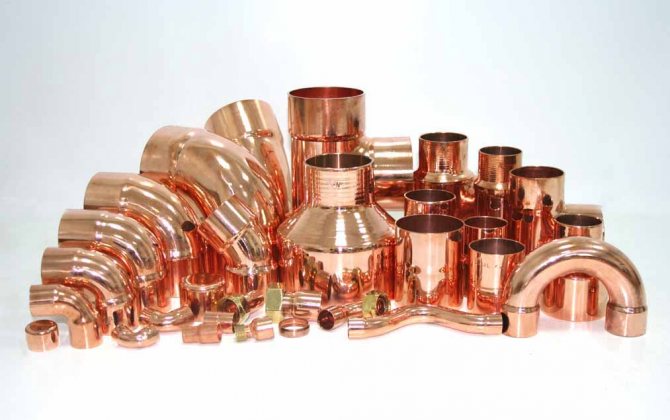

Many inhabitants associate the durability and reliability of the pipeline precisely with the use of copper pipes in household communications. For a long time, this metal has been used in plumbing, sewerage and heating circuits in order to prove itself exclusively from the best side.
The presence of special couplings and fittings facilitate the connection of copper pipes, which allows you to carry out or change them yourself. Depending on whether external or internal fastening, either a split or one-piece method of mounting the circuit is used.
The nuances of working with copper pipes
To carry out the installation of internal pipelines in the house, you can choose a pipe made of plastic, metal-plastic or stainless steel. But only a copper analog is able to serve without problems and overhaul for more than half a century.
Correctly mounted copper piping systems in practice work properly throughout the entire service life that is assigned to a cottage or apartment building.
Copper pipes are not afraid of prolonged heat loads, chlorine and ultraviolet light. When freezing, they do not crack, and when the temperature of the internal environment (water, wastewater, gas) changes, they do not change their geometry.
Unlike plastic counterparts, copper piping does not sag. This plastic is susceptible to expansion at high temperatures, with copper this does not happen by definition.
There are two drawbacks to tubular copper products - the high price and softness of the metal. However, the high cost of the material pays off with a long service life.
And so that the walls of the pipes are not damaged from the inside by erosion, filters must be installed in the system. If there are no contaminants in the form of solid particles in the water, then there will be no problems with the destruction of pipelines.
Pipe processing and welding requirements
When working with copper pipes, the following rules must be observed:
- When installing cold water or hot water supply by soldering, the use of lead solder should be excluded - lead is too toxic.
- The water flow rate should not exceed 2 m / s, otherwise the smallest particles of sand or other solid matter will gradually begin to destroy the pipe walls.
- When using fluxes, after completion of the installation, the pipeline system must be flushed without fail - the flux is an aggressive substance and will contribute to the corrosion of copper tube walls.
- When soldering, overheating of the joint must not be allowed - this can lead not only to the formation of a leaky joint, but also to a loss of strength of the copper product.
- Transitions of pipes from copper to other metals (steel and aluminum) are recommended to be made using brass or bronze adapter fittings - otherwise, steel and aluminum pipes will quickly begin to corrode.
- Burrs (metal beads) and burrs in the places of cutting must be removed - their presence leads to the formation of turbulent eddies in the water flow, which contributes to erosion and a decrease in the operating life of the copper pipeline.
- When preparing copper pipes for connection, it is strictly forbidden to use abrasives - their remaining after installation inside the particles will damage the metal and form a fistula.
If in the water supply or heating system in the house, in addition to copper, there are also pipes or elements made of other metals, then the water flow should go from them to copper, and not vice versa. The flow of water from copper to steel, zinc or aluminum will lead to rapid electrochemical corrosion of the pipeline sections from the latter.
Due to the ductility and strength of the metal, copper pipes are easily cut and bent. Piping can be rotated using either a pipe bender or fittings. And for the device branching and connections with various devices, there are many parts made of heat-resistant plastics, brass, stainless steel and bronze.
About the interaction of copper with other metals
In most private houses, domestic water pipes are assembled from steel and aluminum pipes. Heating systems also include steel or aluminum radiators. Incorrect insertion into such a copper pipe layout is fraught with considerable problems.
The most optimal installation option is the use of pipes and devices exclusively made of copper and its alloys. Nowadays, bimetallic aluminum-copper radiators, as well as the corresponding fittings and shut-off valves, can be found without any problems. It is worth combining different metals only in extreme cases.
If overlap is unavoidable, then copper should be the final one in the chain of pipeline elements. It is impossible to rid her of the ability to conduct electric current.
And in the presence of even a weak current, this metal creates galvanic vapors with steel, aluminum and zinc, which inevitably leads to their premature corrosion. When installing a water supply system, it is imperative to insert bronze adapters between them.
Another potential problem is oxygen in water. The higher its content, the faster the pipes corrode. This applies to pipelines both from the same metal and made from different ones.
Often, the owners of cottages make a serious mistake, often changing the coolant in the heating system. This only leads to the addition of completely unnecessary portions of oxygen. It is best not to completely change the water, but to top it up when the need arises.
Push-in fittings, their types and applications
The modern market offers a wide range of auxiliary parts for connecting copper pipes without soldering (threaded method, for example) or by high or low temperature welding. Copper is a very easy and malleable metal, so even a beginner can handle it with the tools.
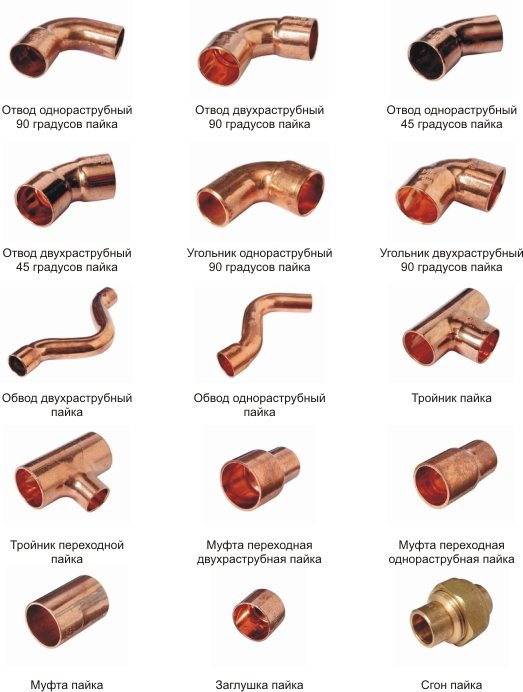

Push-in fittings for copper pipes are the easiest way to install line elements, because they are based on a clamping ring that is put on the tube and a nut that fixes the clamping point. This method of connection is quite simple and does not require special tools.
Most often, similar fittings for copper pipes are used:
- When conducting a line through which hot or cold water, gas or oil circulates. In pipelines in which the chemical medium does not exceed a heating of 175 ° C. The pressure in such systems should not exceed 16 atmospheres.
This type of installation is considered very reliable and tight, and the collet connecting fittings for copper pipes presented on the market today are available with an inner diameter of 8 mm to 100 mm. If pipes of a larger diameter are to be installed, then another method of joining them should be chosen.
There are the following types of collet fittings:
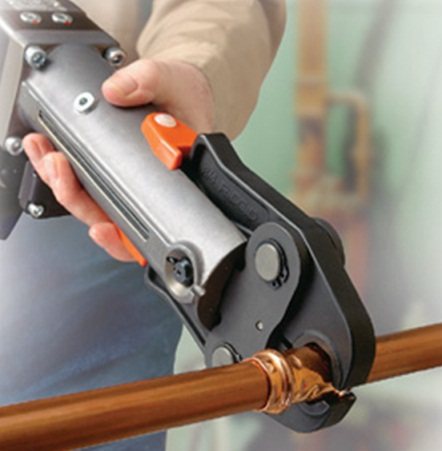

- Coupling for copper pipes, as a rule, is made of copper or the alloys in which it is included. Its function is to join contour elements of the same metal and the same diameter. Copper adapters for copper pipes are used to connect pipes of different diameters. They can also combine products from different materials, but it is better to choose brass counterparts. The branch connector for copper pipes is an angle that allows you to join the network elements at an angle from 45 ° to 120 °. When separation of the flow is required, a collet cross or tee is used .When connecting a flexible hose to a pipeline element, a union is used.
Push-in fittings are the most commonly found parts in domestic and industrial piping. This is due to their following advantages:
- They are affordable. Simple enough to use. Quite a wide range offers models for lines of any length and complexity. To work with them you do not need special equipment and a beginner can handle them. Push-in fittings provide a reliable tight connection. They are durable, like pipes. made of copper, but if necessary, they can be reused or as a temporary docking.
Since the clamping point weakens over time from loads and requires tightening, such a connection is used exclusively when external fastening of copper pipes to a wall, for example, is carried out. Access to the docking point is an important factor for such a pipeline.
Installation steps:
- Pipes are cut into lengths according to the diagram and cleaned. If necessary, calibration is carried out to obtain an even hole. A nut is put on the end of the tube, and then a collet. The end of the fitting with rubber bands is inserted into the tube. The clamping nut is screwed manually onto the thread of the fitting and gently the collet is tightened. The nut should be tightened with a wrench, but allowing for pinching.
Pulling up the collet, you need to make sure that there is no skew, otherwise all the work will have to be done again. When tightening the nut with a wrench, it is important not to overdo it, otherwise the copper will crack, and this piece of pipe will have to be cut off.
Compression fittings
It is the crimp ring for copper pipes that ensures the reliability of joining the individual elements of the pipeline. Above was described how to use a push-in fitting with such a ring on regular pipe ends. When a flare connector for copper pipes is required, compression fittings are also used.
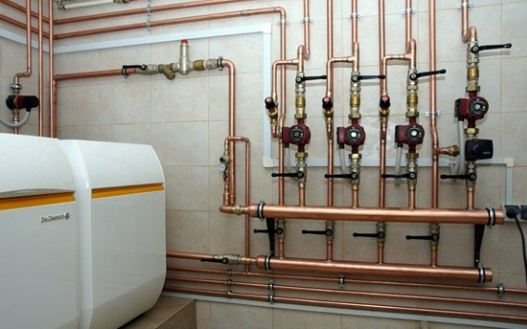

Pipe flaring can be done by yourself if you have special equipment. In order to expand the end to the desired size, it is better to use a flare tool, with which you can make the necessary calculations and calibrate.
Compression fittings for flared copper pipes consist of a sleeve and a clamping nut and are just as easy to use:
- A coupling is put on the prepared and cleaned end of the tube. The end of the other pipe is inserted into the expanding machine or expander and rotated until it forms an edge at an angle of 45 °. The second end of the coupling is inserted into the finished rolling and tightened with a nut.
Compression fittings for copper pipes are used exclusively in outdoor piping and are part of the service system. If they were used in annealed (soft) products, then a visual examination is enough for preventive checks, while in unannealed ones, tightening the clamping nuts will be required.
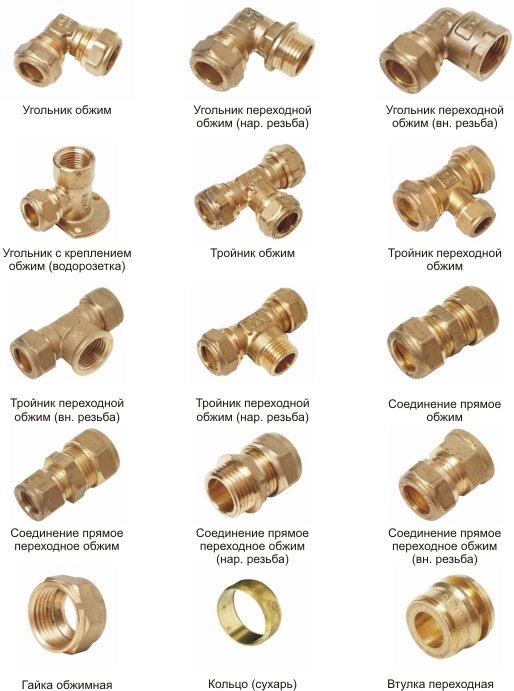

The connection of copper pipes with crimp fittings is most often used when carrying out repairs to a circuit or as temporary parts when wiring a new line. They are reliable, durable, but require periodic testing of the quality of the seal.
Method # 3: Press-connect
The connection of copper pipe and copper alloy fittings by means of a crimp bonding method is fast, economical and does not require soldering technology. The press-connect method appeared in Europe in the late 1950s and is still used successfully today. Since the late 1990s, this connection method has spread throughout the world.
PRESS COPPER
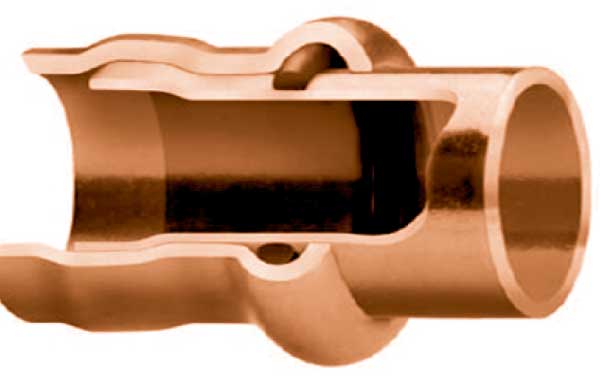

Structural view of a mechanical bonding crimp connection ("press-connect"), where high tightness is achieved through the use of an elestromer seal
The practice of using a bonding crimp joint has shown satisfactory results. As in the previous (# 2) variant, it uses the plasticity effect and the pronounced strength of copper during cold working. The connection with a binding crimp provides for the presence of:
- special fitting,
- elastomeric gasket,
- crimping tool,
- special sponges.
Typical pressure and temperature ranges for bond crimp connections are shown in the table below:
| Connection type | Pressure range, kPa | Temperature range, ºC |
| Crimp binding, D = 12.7 - 101.6 mm | 0 – 1375 | minus 18 / plus 120 |
| Crimp bonding under high pressure, D = 6.35 - 31.75 mm | 0 — 4826 | Minus 32 / plus 150 |
Threaded fittings
Threaded connection of copper pipes is the most common, since they can be easily replaced or reused on occasion. Fittings of this type can have both external and internal cylindrical threads.
The pipeline is far from the only place where such parts are used, and they are often part of the connections of plumbing elements. By configuration, threaded fittings for copper pipes are divided into:
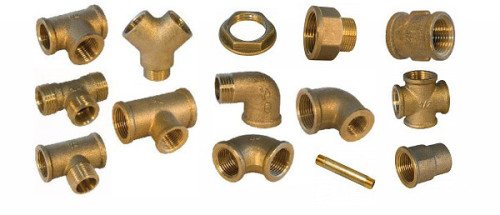

- elbows; nipples; couplings; plugs; bends.
For the connection of copper elements, fittings should be selected from brass, copper or alloys with its content.
If you are going to use a threaded fitting on a soft copper pipe, it is recommended to "secure" the joint with a support sleeve, which will allow you to tighten the nut tightly without deforming the metal.
Thread with a cutter
So, first, we divide the pipe into the necessary parts of a certain size. But how can this be done, since the pipe is made of rigid material? The cuts must be made using a device that, rotating around the circumference, is tightened until it stops. Such movements must be repeated cyclically until the pipe is cut into parts. The threading process consists in putting the cutting part of the product on the pipe and slowly moving it to the section of the pipe where it is planned to make the cut. In order for the screw to tightly envelop the circumference of the pipe, it must be tightened more firmly. Then it is necessary to move the cutting part of the tool with rotary movements along the circumference of the pipe, while controlling the degree of tightening of the clamp. Naturally, a hand saw can be used for the process of cutting copper pipes, but in this case, the edges of the cut will have a rather uneven appearance. Then additional work will be required in the form of getting rid of roughness. So, after the pipe has been divided into parts, you can start the process of processing the edge sections.
Edging after the cutting process
It is necessary to do the cleaning of the pipe from a variety of roughness. For this, in most cases, a tool such as a small file with a fine notch or an arched file is used. Cleaning should be done with careful movements, slowly, making sure not to comb out excess.
Edge alignment process
In this process, you cannot do without the help of skins of different varieties.But, to a greater extent, a small skin is used. The process is very simple and easy. When a shine is visible on the surface, the polishing process should be stopped. Then it is worth proceeding to the processing of the inner part of the pipe in the region of the edge sections. Faithful helpers in this matter will be special devices that look like brushes. You can easily purchase them in a specialized store. Of course, control the level when you need to stop stripping, as if you are stripping large amounts of raw material, it may be difficult to solder.
Surface coating with flux
To cover the surface with flux, a prerequisite is the use of brushes, since this substance is very toxic and harmful to human health. Care must be taken when using it to avoid contact with fingers and eyes. If the contact does happen, it is necessary to urgently rinse the damaged areas of the body with water. So, you need to apply a thin layer of the substance from all sides of the pipe, including its inner part. Next, the process of attaching a pipe with a fitting follows. It is required to connect as tightly as possible to each other, scrolling it around the circumference to allow the flux to spread in equal parts over the entire surface. If the residues of the substance remain on the outer surface of the product, they must be removed.
Treatment with a burning substance
What is a burner? A burner is a device that helps burn fuel. So, the burner must be ignited and directed at the pipe joints. Next, you need to warm up the fitting over its entire surface. Take into account the temperature indicator to which it is worth bringing the pipe with the fitting. It should be similar to the temperature at which the connecting substance melts.
Uniform solder filling
After the result in relation to the temperature is reached, the solder begins to melt, you should touch the tip of the solder to the junction of the pipe with the fitting. You should go around the circumference of the joint. Next, it is worth checking that all the edge areas are covered with solder and there are no gaps left. After making sure of this, it is necessary to allow the structure to cool down. Among other things, care must be taken to ensure that when working with solder, the flame of the soldering torch must touch the pipe. How exactly does the solder get into the connector gap? Capillary forces help him in this, the solder can move and get into space both horizontally and vertically. Not to mention the temperature index of the melting of the solder, when choosing it, you need to be guided by the fluid pressure that is present in the pipeline. International quality standards prescribe that the concentrate of lead mass in solders and fluxes should not be higher than 0.2%. This indicator applies to sewerage systems.
Press fittings
The one-piece connection is considered the most reliable, and it is precisely this connection that is used when the pipes are to be "hidden" in the floor or wall. One of the elements of such a system are press fittings for copper pipes.
At the heart of these parts are special polymer seals, and to assemble the pipeline you will need:
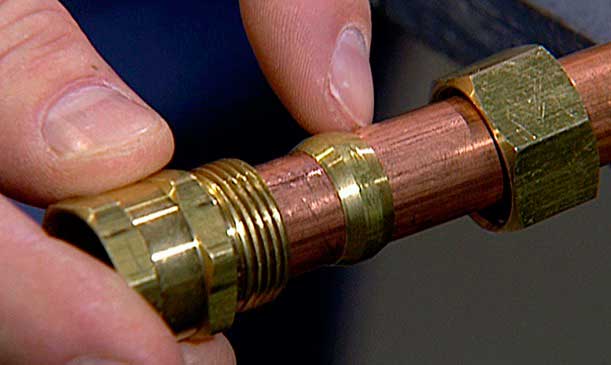

- Cut and strip the pipe to the required length. Calibrate the hole. Insert the pipe ends into the press fitting. Squeeze the joint with a copper pipe clamping pliers.
This method of connection does not require heating of parts and is considered one of the fastest. If the amount of work to be done is small, then you can purchase a manual press for copper pipes, for which, apart from little physical effort, nothing is required. It provides the required tightness by compressing the connecting fitting against the seal ring.
The electro-hydraulic copper pipe press is used by professionals when laying long lines with numerous connections.More expensive equipment has replaceable couplings, thanks to which it is possible to connect pipes of different diameters from any manufacturer.
To carry out repair or installation work on your own, you can rent a press for copper pipes, which is more profitable than spending money on a tool that may not be needed the next time soon.
How to bend copper pipes correctly
In the photo above, the numbers indicate
- The pipe is inserted and fixed in the grip of the pipe bender at the beginning of the bend.
- Applying force, gradually turn the movable handle of the lever pipe bender, bending the pipe around the mandrel.
- You can also bend the pipe using a spring with a diameter corresponding to the diameter of the pipe.
Flaring pipes
In the photo below, the numbers indicate
To connect pipes with fittings with union nuts (especially when repairing connections), flaring has to be done.
- If necessary, remove the union nut by cutting off the flared end of the pipe.
- You can cut the flare with a roller pipe cutter by sliding the nut along the pipe.
- To restore the flaring, the pipe is clamped in a die so that the end of the pipe protrudes about 1 mm above the die surface.
- By tightening the screw of the device, the end of the pipe is deformed to form a conical expansion.
- After removing the screw clamp, check the funnel-shaped flare, which must have the correct shape.
- The end of the pipe can be flattened with light hammer blows by re-clamping the pipe in the die.
- A smooth and even flaring surface can be obtained with a velvet file.
- It remains to put the sealing gasket and the pipe can be connected.
- If necessary, flaring can be done on fittings, for example, couplings, elbows.
How to expand a copper tube
To connect pipes by soldering without using connecting fittings, the end of one pipe can be widened using special pliers.
Having inserted the pipe into pliers with a head of the required diameter, force is applied to the handles of the pliers, expanding the end of the pipe.
After expansion of the pipe, a mandrel-caliber is inserted into the pipe and, with light hammer blows on the mandrel, the diameter of the expansion is brought to the required expansion with the help of special pliers.
Soldering
It is believed that soldering is the most reliable way of joining any pipes, and copper pipes are no exception. It can be produced by high temperature or low temperature connection. The latter includes fittings for copper pipes for soldering.
Many consumers prefer to deal with parts into which the manufacturer has inserted solder during the manufacturing stage. As a rule, it is placed in a specially made cavity in the socket and most often there are fittings with low-melting solder, for which the temperature of a blowtorch or a building hair dryer is enough to heat it.
The connection technology is very simple:
- The ends of the pieces of copper pipes are cleaned. They are inserted into the fitting (you can use an American for soldering copper pipes). Heat the part with a blowtorch or a hairdryer so that the solder melts and spreads, soldering the pipes with it. Do not move or move the joint until the joint has completely cooled.
This simplest method of brazing copper pipes, although it is known to the domestic consumer and is gradually gaining his sympathy, is still most popular in Europe and Asia. Some of the crafters prefer to see how much they are using solder by using hard grades and using high temperature equipment.
The main types of copper pipe connections and tools for this are shown in the table below.
Joining methodDetailsJunction toolsConnection typeLow-temperature capillary solderSoft solder, fittingsBurner sealedHigh-temperature capillary brazingHigh-temperature capillary brazingHigh-temperature capillary brazingHigh-temperature capillary brazingHigh temperature capillary brazingHigh temperature capillary brazingAcetylene torch solderburner-detachable Pressing-fittingsPress - pliers non-detachableCompression connectionCrimp fittings
As a rule, for independent work, consumers choose special fittings, which, with a small investment of time and money, provide a high-quality connection of copper pipes. Any of the listed types are suitable for joining a pipeline made of this material. The choice depends on the experience of the master, the complexity of the circuit and the external or internal installation method.
Installation of copper pipes: detailed instructions
Articles
If you want to conduct or repair a water supply system, while there is a desire to do the installation of copper pipes with your own hands, you will probably need to learn more about this in more detail.
If we turn to the modern varieties of water pipes, then, for example, copper pipes are perfect for installing a water supply system in residential buildings: they are smaller than steel types, are prone to corrosion, are more reliable than plastic ones and are quite easy to install.
How to choose the most suitable copper pipes for a particular water supply system? Our article will answer this and other questions.
Installation of copper pipes
Advice!
When choosing a pipe material, it is necessary to pay attention not only to the advantages, but also to the disadvantages.
The choice in favor of copper pipes is usually made when significant pressure in the water supply system and / or sudden temperature changes are expected.
Features of the installation of a copper pipeline
Installation of copper pipes for water supply is carried out in two ways: by soldering or by means of a threaded connection with a ferrule.
The second method is so easy to perform that it is suitable even for a beginner. In this case, no specific tool is required: copper pipes for the water supply system are easy to mount using ordinary wrenches, which tighten the connection. When choosing a fitting, it is necessary to pay attention to the diameter of the copper pipes.
Brazing can make copper pipes more secure, but this method requires some skill and safety.
Materials for the device of a copper pipeline
Materials required:
- Directly pipes - for the future water supply system, a detailed diagram should be drawn up, the required footage of pipes should be calculated. If you are performing installation for the first time, copper pipes must be purchased taking into account a small stock. Sometimes copper pipes insulated with PVC are used as a hot water supply pipeline - if this is your case, at the end of the pipe it is necessary to remove the insulation near each connection.
- Fittings for copper pipes. If you plan to solder the pipes, then the fittings should be selected "for soldering", if "twisted" - crimp fittings will do. These can be tees, elbows, couplings, adapters from one diameter to another. It is better to select them according to the scheme drawn up earlier.
- Fum tape for sealing threaded connections.
- Flux and solder for copper pipes.
Installation of threaded copper pipes using ferrules
This connection is collapsible, but if there is a need to dismantle it, the ring will need to be replaced. Copper pipe laying involves timely tracking of problems and replacement of parts if necessary. Thus, it will be necessary to proceed after each disassembly, if any are required.
Types of fittings for connecting copper pipes
This type of connection is performed according to the following scheme:
- Cut a piece of pipe to the desired length.
- When using PVC-insulated pipes, the insulation layer will need to be removed from the end of the pipe. An incision is made with a sharp knife, after which a piece of insulation is removed by hand.
- The burrs formed after the cut are removed with a file.
- The fitting is prepared.
- First, a union nut is put on the pipe, then a compression ring.
- The nut is docked with the compression fitting, after which the threaded connection is tightened. The nut should be screwed on smoothly - first with your hands, then with a wrench, when it becomes difficult to do it with your hands. In the process, the ring compresses the pipe and the joint is sealed.
When connecting a transition fitting from a steel pipe to copper pipes, the installation involves sealing using fum tape or tow with paint. First, a tape is screwed onto the thread, then the fitting is screwed in.
Soldering copper pipes
The pipes are brazed in the following way:
- The required piece of pipe is cut with a hacksaw or pipe cutter.
- Heat insulation at the end of the pipe is removed.
- Burrs formed after cutting the pipe are removed so that the resistance to water flow does not increase in the future.
- A small sandpaper removes the oxide film from the place that is being prepared for soldering. In this case, it is better to sand the fitting as well.
- With a dry cloth, carefully wipe off the dust left after the removed oxide film. If copper pipes are chosen for the water supply, the installation must be carried out in compliance with all the rules.
Brazing copper pipes - A flux is applied to the surface prepared in this way. It is used for uniform spreading of solder over the area required for operation.
- The end of the pipe is inserted into the prepared fitting. In this case, there should be a gap between the copper pipe and the fitting, the value of which should not be more than 0.4 mm.
- The next step is to warm up the connection with a gas torch for brazing copper pipes. If you don't have a torch, a blowtorch will work fine. The flame should move evenly along the seam so as not to overheat individual areas. To check if the joint is hot enough, you need to touch it with solder. If it melts, then the temperature is right.
- After that it is necessary to seal the seam. To do this, the solder is inserted into the gap that is usually obtained after inserting the pipe into the fitting. You will have to try to keep the fitting and pipe stationary during this operation - they should not be touched until the solder has completely crystallized.
Advice!
After the installation is completely completed - the copper pipes are arranged in place, the system should be well rinsed so that no impurities such as flux remain in it.
Especially for those who want to carry out repairs or the installation of a water supply system in their home as best as possible, we can offer a visual installation of copper pipes video. It will allow you to understand the progress of the process more fully and in all details.
Source: https://o-trubah.ru/materialy/mednie/montazh-mednyh-trub-239
